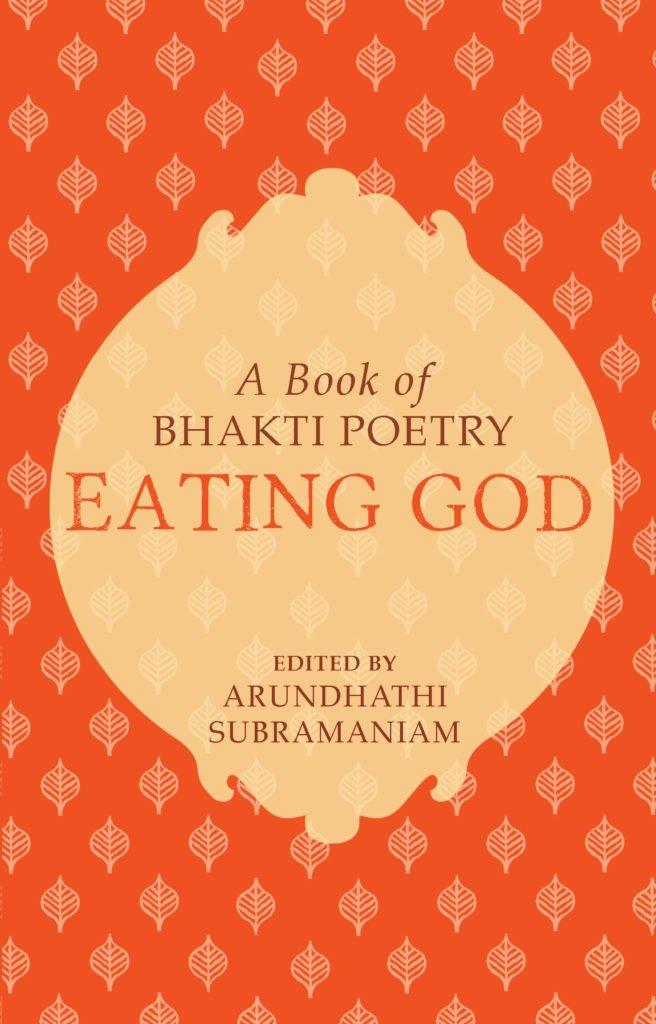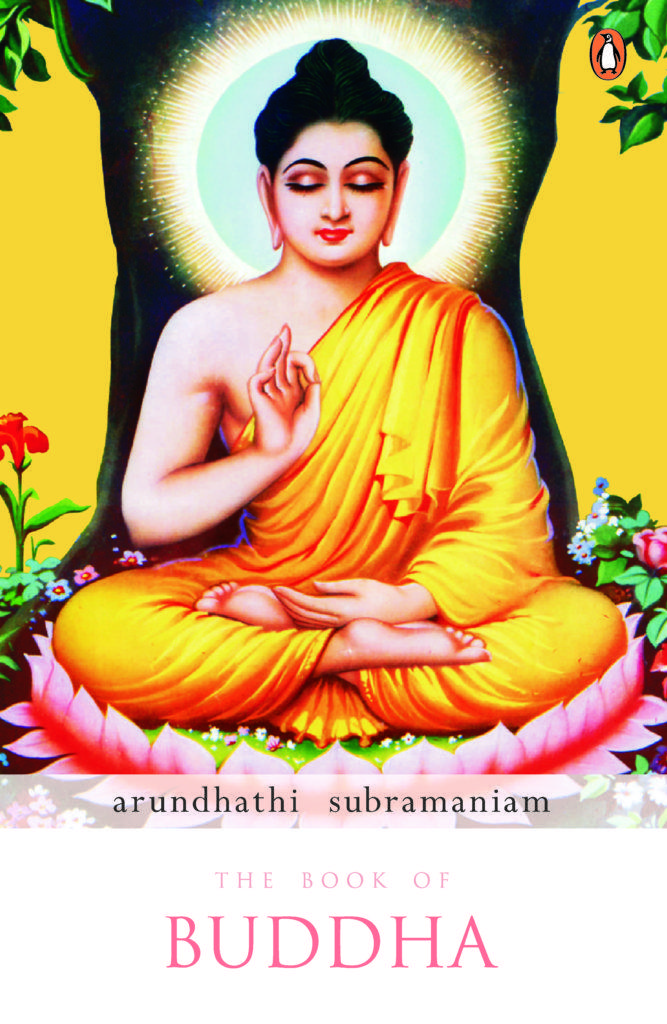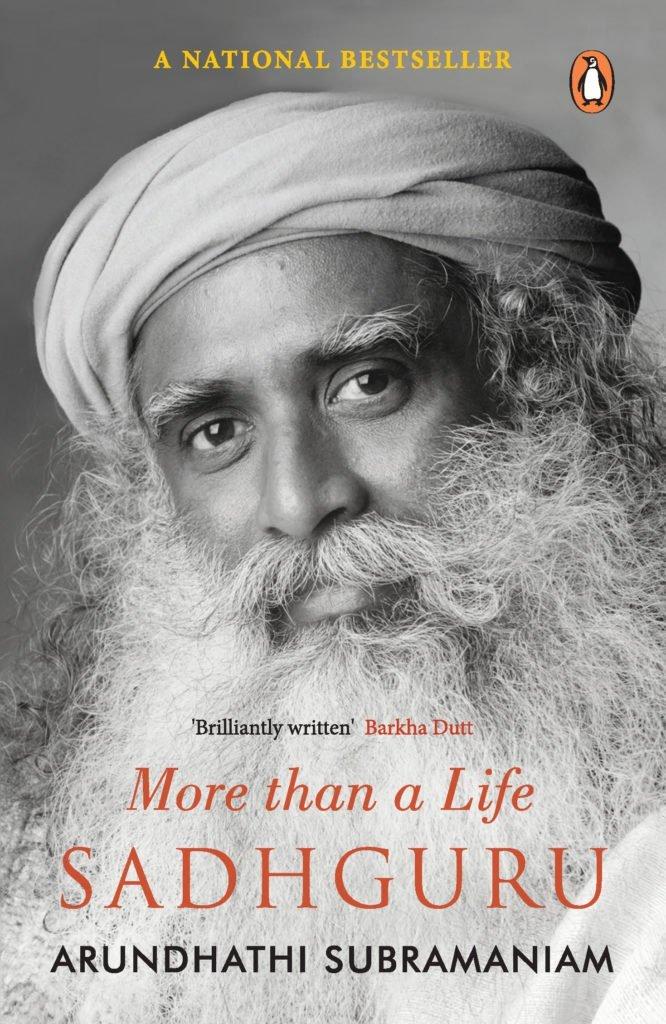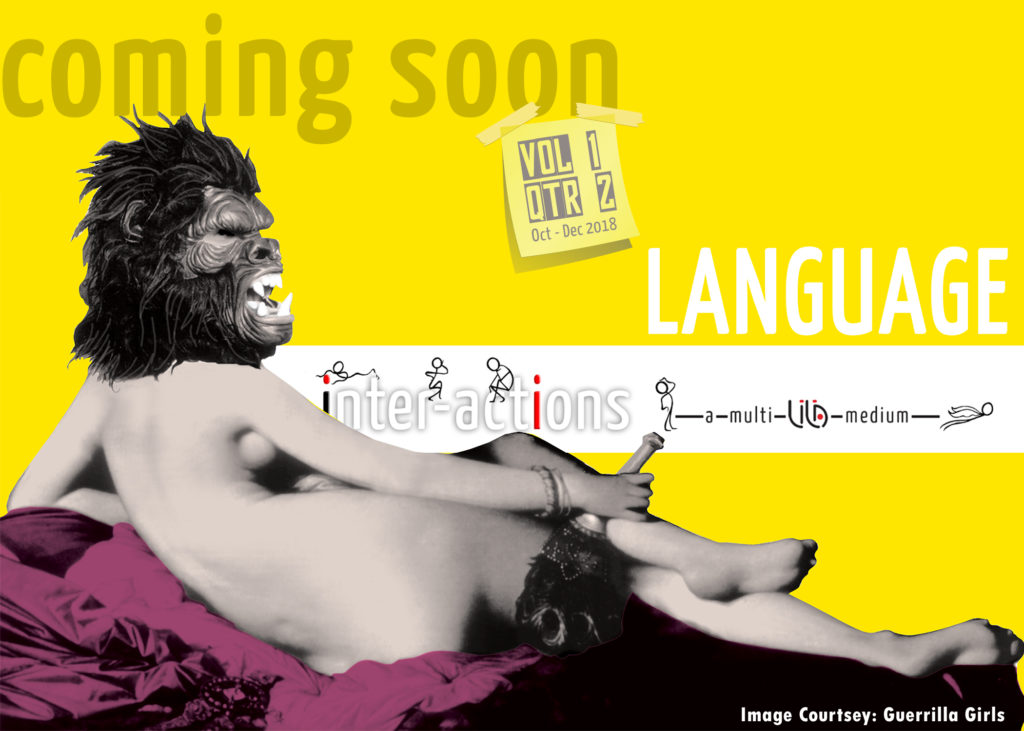LILA: Thank you, Arundhathi, for agreeing to converse with us here at Inter-Actions. Talking about ‘master minds’, let us start with the poet, as you are a poet yourself. You once said (and I paraphrase) that poetry is the art of making something that has already been said before sound new. Could you elaborate on this process, as you understand it? How do you seek to be, or engage with, a creative mind that acts thus?
AS: Thank you. I look forward to this conversation.
I suppose I think of poetry as language in its most nascent state. Energised, liquefied language. Language that electrifies although it is familiar. That shocks although it feels inevitable. That’s the paradox. Poetry feels sudden and recognisable all at once. It’s the most direct verbal journey to ‘knowing’ something. It gets there before any other mode of language – before prose, before any cogently formulated thought. And it says it for you – in direct, searing shorthand that combines authenticity with artistry. It jolts you into the feeling of ‘Oh, I knew that all along, but somehow never quite put my finger on it.’
How do I cultivate a mind that might allow for the making of poems? Well, in many ways. One way has probably been through reading other poets – reading widely, rigorously, attentively and omnivorously. When I was much younger, conversations with other poets helped – talking, discussing, workshopping with them. All this helped shape my understanding of form. But apart from the ‘doing’, allowing for poetry is also important. Poems don’t happen if you don’t wait for them. Conscious idling is essential. If you think sitting around with an empty page or computer screen is a waste of time, a poem is unlikely to find its way into your life.
What’s also helped, personally, has been having a spiritual practice. It’s helped me hear the timbre of my voice more clearly. It’s also helped clear some psychological noise – the barrage of ‘oughts’ and ‘shoulds’ that one imbibes unconsciously from the cultural climate. And it’s allowed me to trust the creative process a lot more. Poetry is about choreographing language, but also about the right measure of trust, even conscious inattention. I’m less inclined now to micro-manage the process. I follow the lead of a poem, and give myself the license to eavesdrop on myself.
LILA: Apart from poetry, you have also written on two lives, that of the Buddha and Sadhguru Jaggi Vasudev. Two people separated by millennia. One alive among us, one supposedly eternal. Masters in different contexts, yet, considered to be connected in a spiritual continuum. As a poet whose art has been shaped in Mumbai, largely appreciated as the commercial capital of the country, how did you develop an interest in these subjects?
AS: Well, to be fair, Bombay/Mumbai/Bambai has many names because it has many faces. It is the commercial capital, certainly. But it is also the city of many languages, many literatures, many cultures. And a harbour city. I’ve always believed the sea never allows it to get too smug and landlocked and insular! At least not beyond a point.
Looking back, I would say that my fascination with the spiritual started early. It was apparent in many of the early stories and poems I was writing as a child of the age of ten or eleven. There were very real questions about pain, loss and transience there. And I don’t think that’s particularly new. Many children have these preoccupations.
I decided pretty early that poetry was going to be central to my life. But an eclectic combination of Alan Watts, J. Krishnamurti, Will Durant and Radhakrishnan also sustained me through my teens. That deepened into more structured reading later. And I would probably have been quite content to be a weekend reader of philosophy and enjoy the seductive tensions of metaphysical argument from a safe distance for the rest of my life. Except one day, things changed quite irreversibly. It was a decisive moment in March 1997. I have written about it before in my introduction to Sadhguru’s biography. I’ve also talked about it in interviews before. So, let me just say, very briefly, that it was an experience that felt like death. There was no external impetus for it – I wasn’t ill or depressed. In fact, it occurred after a particularly relaxed vacation in Nepal. But the experience of ‘dying’ lasted about a week. There was a certain freedom in realising that nothing that I had ever worried about really mattered – in fact, it didn’t matter in the least. But there was also terror. The terror of losing everything I had valued – the people and animals I loved, books, conversation, travel, the world as I knew it, even language – and not finding anything of value to replace it with. There was a kind of mute bewilderment. I kept hoping things that I would be ‘rescued’ or ‘illuminated’ in some way. But nothing happened. There was only this unrelenting emptiness. And as I emerged from that experience with great relief about a week later, I also knew that I had to spend the rest of my life trying to make my peace with it. Everything took on a new urgency after that. I was no longer just a reader, who believed a combination of Wallace Stevens and Neruda, garnished by a little Zen and a seasoning of Indian philosophy, could answer my life questions. Nor could I believe my love of Indian classical dance and theatre would resolve all my existential dilemmas. The only books that did help me were those by mystics, not philosophers. I began to read these – Sri Ramakrishna, Nisargadatta Maharaj, St John of the Cross, Ramana Maharishi, Meister Eckhart – with a crazy feverishness. Later, the Bhakti poets – from Tukaram and Nammalvar to Akka Mahadevi and Annamacharya and others – became increasingly important (more recently, leading to my Penguin anthology of Bhakti poems, Eating God).

What shifted in an enduring way was how I saw myself. My fundamental self-definition now was no longer ‘poet’ or ‘writer’. I was just a seeker, willing to take crumbs of guidance from wherever I could receive it. Reading the mystics helped. But when a living guide happened seven years later in 2004, it was a significant turning point.
And so, the books on the Buddha and Sadhguru unfolded – the first was published in 2005 and the second in 2010 – not as a result of any detached academic interest, but a pretty desperate search. The Buddha had always fascinated me, and the book was a passionate and, I think, reasonably thoughtful attempt to understand that fascination. The Sadhguru book was an attempt to tell the extraordinary story of a living mystic. It wasn’t an exposé and it wasn’t a hagiography. The tone of the book is a mix of wonder and enquiry – a mix that for me was an integral part of the book’s approach.


Left: The Book of Buddha by Arundhathi Subramaniam (Penguin India, 2006)
Right: More Than a Life: Sadhguru by Arundhathi Subramaniam (Penguin India, 2010)
LILA: For most people, spirituality is a realm that is hardly distinguishable from the religious. Can you shed some light on the nature of spirituality as a field of engagement? Have your experiences of dealing with the lives of these minds helped you understand spirituality?
AS: Well, the connotations that the word ‘religion’ has acquired have been unfortunate. And I suppose it isn’t surprising. The religious has been associated, over time, with mechanical, sometimes exploitative, systems of belief and observance. And it has often been messed up by some either juvenile or mystifying understanding of the divine – one that is frequently dogmatic. It often seems like a system of ‘selling water by the river’ – commodifying what ought to be freely available. I think we’ve all experienced this sense of disconnect with formal religion at some point, whatever our persuasion.
The spiritual, on the other hand, rescues what counts from what might seem like the carapace of religion. And what does count? I guess I would say that any practice that deepens your ability to live with uncertainty and with mystery – that deepens your ability to live in wonder, that hones your receptivity to the way things are, that invites you to inhabit yourself more fully and deeply, that urges you to take greater responsibility for your life – could be deemed a useful spiritual practice.
In a sense, poetry does this for me too. But I believe a spiritual process, accompanied by spiritual guidance, takes one deeper. It makes one less rigid, less inclined to reach for easy conclusions and certainties. Also, more anchored in oneself. This anchorage doesn’t mean a cultural or political or geographical or psychological identity. Instead, it’s a way of belonging not just to places, people, situations, but also to oneself. It’s a growing inner anchorage. Putting down firmer existential roots, if you will.
Personally, there’s much further to go, of course. Much further. But this deepening makes an otherwise scarily non-signposted inner journey feel worthwhile.
LILA: Do you think some human minds are more spiritually inclined than others? Can you share your thoughts on this with respect to your engagement with Jaggi Vasudev and the Buddha?
AS: Well, some people do seem to be born with a strong inner proclivity: just like some are musically gifted or mathematically inclined, perhaps some are more spiritually oriented. But with the right mix of passion, application and humility, most of us can achieve much more than we imagine in a field of our choice. I’m sure of that. I certainly know that to be true of the arts. It is something I remind participants in poetry workshops of all the time.
Let me start by saying what drew me to these two figures.
The Buddha draws so many of us, in fact, because he is the ultimate spiritual democrat. He tells us that the spiritual path is not just for the card-carrying elect. Everyone is invited – regardless of caste, class, gender or creed. At the same time, he offers us a path that requires diligent practice, hard, unrelenting inner work. And so, everyone is a potential Buddha, but without perspiration and inspiration in generous doses, not everyone realises that potential.
The Buddha is inspiring in particular because of his rationality, his common–sense, his psychological astuteness, his pragmatism. For me, he is inspirational as an individual who staked his life on the inconvenient questions he asked; as an individual who opened up a path that was hospitable enough to include not just professionals, but unlicensed amateurs too; and above all, there is the inspiration of his persona – handed down to us by traditional scripture and calendar art – of unwavering serenity, of inscrutable inner equipoise.
Before I met Sadhguru in 2004, I had always assumed that if I ever had a guru, she would be female. And if he had to be male, I imagined a textbook Buddha – gentle, compassionate, wise, serene. Compassion and wisdom, Sadhguru has in plenty. But he was, in other ways, the antithesis of all I had imagined! Instead of some comforting bovine placidity, there was this intensity, this volcanic aliveness. There was also his unsparing clarity – his most defining characteristic. These qualities in particular drew me. And there was his language – contemporary, energetic, incisive, funny. And most of all, it felt like this was someone who wasn’t coming from a place of scholarship or academic learning, but from inner knowing. There was the smell of authenticity here.
So, to return to your question, I think both these figures are interesting because they start out as pretty ‘regular’ people, not particularly distinguished in any way, and only later find their calling: Siddhartha began as a young man of privilege who only later turned mendicant and seeker, and Jaggi began as a young sceptic-agnostic before his life-transforming experience on Chamundi Hill. Neither of them starts out as a likely candidate for the spiritual life. And so, by their very example, they interrogate and extend our ideas of the sacred. They remind us that to ask for personal answers to the big questions of life and how to live it is not outrageous. It is our birthright.
Also, both of them invite us (as all real gurus do) to a life of self-determination, not dependence. In other words, they tell us we can cultivate the spiritual faculty. It is not inherited, not a genetic boon conferred on just a few. But they tell us that it takes hard work – even if the sadhana is to realise that there is really no special gift to be acquired, just the sharpening of receptivity.
I remember once asking Sadhguru about the Biblical line, ‘But many are called and few chosen’. It was a line I liked. It always seemed resonant. At the same time, it seemed unfair. Why were some chosen and others not? And who was this divine despot that was doing the choosing, anyway? I have never forgotten his response. He said, “It would be more accurate to say, “Many are called, but few choose”. It helped me to hear that it didn’t take some special badge of identity. That we can all be called, if only we choose.
LILA: Jaggi Vasudev is often referred to as a contemporary mystic. From your experience of writing his life, do you think this term describes him well? If so, what does it mean? If not, what other term would be apt to describe him?
AS: ‘Mystic’ is probably the description I like best. He is not a philosopher, scholar, or pundit. He is not coming from a place of acquired knowledge, but inner knowing. How else would I describe him? A sage or rishi, perhaps, but those sound like geriatric figures, don’t they? A shaman, or alchemist, perhaps, but those can sound a bit new age–y. I’ve actually used all those epithets at various points, but I think ‘mystic’ probably sums him up best. What does it mean? I suppose, someone with a deep experiential understanding of human interiority – of the non-physical dimensions of human life, of the existential questions of life and death.
LILA: In India, the boundaries of philosophy and religion are blurred. While, the shad-darsanas as well as tantric philosophies are often appropriated as a product of the Hindu religion, Sufism broadens the established understanding as well as practice of Islam in many parts of the country. In other words, philosophy and religion are not understood as separate disciplines in Indic traditions. On the one hand, while the academic study of philosophy has hardly any takers, the same when delivered by gurus and religious teachers, is regarded and celebrated. On the other, the gurus are also often dismissed by intellectuals due to the larger perception that they are non-secular. How do we practise to think about and understand these intertwined histories?
AS: There is a very simple reason why many more seem to be drawn to a contemporary spiritual movement rather than to an academic study of philosophy. You could say the former seems more engaging. But why does it engage? The former engages because it represents the possibility of a much more participatory, self-implicating engagement with a living tradition, rather than an intellectually stimulating exploration of it. You turn to the spiritual when you are willing to be the white-coated scientist and the subject of the laboratory experiment. I am by no means taking an anti-intellectual position here. I’m a votary of the life of the mind, and I know its joys and its passions. And I’m not someone who habitually derides the intellect. But the spiritual begins when one is willing to implicate more than just the cerebral cortex. It implicates mind, heart, body – everything really. There is also a difference between a guru and an acharya. A guru may not hold a doctoral degree or be a scriptural expert or a philosopher; the expertise that s/he represents is experiential, not scholastic. When you thirst to learn from someone who embodies that kind of experiential knowing, you go to a guru; you don’t go to a professor.
About seeing the pursuit of the spiritual as ‘anti-secular’, I think that’s the regrettable fallout of the conceptually fragmented world we live in today. We’ve cornered ourselves into such small cubby-holes. We’ve divided our lives into easy binaries – between the sacred and secular, the material and metaphysical, the worldly and spiritual. We keep telling ourselves we have to live by these dismal and oppressive ‘either-or’ divisions of our own making. This creates all kinds of inner conflicts – and consequently, so much needless torment and suffering.
There’s also great condescension in this attitude. And to see the guru as some kind of paternalistic relic of a bygone age is unfortunate. Not everything traditional is wonderful. But there are certainly aspects of traditional wisdom that are worth salvaging, or reinventing for our times. If we pretend that the spiritual thirst doesn’t exist; that it is some psychological disorder masquerading as the existential; or if we convince ourselves that every guru is a fake, every spiritual movement a con-game, we’re condemning ourselves to very impoverished lives.
Having a guru doesn’t mean passive submission or blind adoration. But undertaking a spiritual journey does mean a rigorous level of inner work during which a guide is hugely valuable. Personally, it’s been a hard-won discovery. So, I don’t treat the concept cavalierly. I’m deeply grateful for having found a guru.
LILA: As religion is steeped in politics, is there a way to meaningfully reclaim the practice of ‘thinking’ in our times? Do the ‘master minds’ that you have engaged with show a way towards this?
AS: Well, what I think any sustained inner work can give you is the ability to view things with more clarity, to be less clouded by your own hidden agendas and investments. It offers the possibility of uncluttered thinking with less psychological chatter. Everyone committed to some spiritual practice can vouch for this. As for mystics, they seem to be capable of this kind of ‘direct seeing’ in a more profound way. They are also capable of an integrated or non-fragmented vision – seeing connections between seemingly disparate objects or phenomena.
How that clarity of perception translates into action is another matter. There is no formula for this. No two mystics are the same. To what extent they choose to engage in the political and social circumstances of their times depends on the individual. And whether we agree with their political views is another matter altogether.
The important thing is what they offer us. And I think it is essentially this: a key to seeing the outside and the inner world, the secular and the sacred, as deeply connected. It is empowering because it is a vision that imbues every individual with responsibility. You are not being encouraged to become your guru; you are being encouraged to become yourself. One of Sadhguru’s lines that has stayed with me is a simple one: “Don’t look up at anything, don’t look down at anything.” It sounds extraordinarily easy. But when one tries putting it into practice, one realises just how much the mind has been hijacked by hierarchy, by ideas of superiority and inferiority.
Does that mean we mustn’t make judgements? Not at all. The world demands judgement for many reasons. But it is possible to make a provisional judgement, aware of one’s own fallibility. There is humility and even humour in that kind of judgement; it allows one to be deeply engaged in a cause without allowing one’s convictions to harden into dogma. It is born of clarity but not rigidity.
I’ve met people who believe that to be spiritual is to be ‘escapist’. Part of the problem is a myopic understanding of the word ‘spiritual’ and an equally myopic understanding of the word ‘political’.
I see poetry as being about enchantment. But I don’t see enchantment as escape. I see it as an invitation to a profound, many-sided truth – deeply enriching and life-altering. We need poets because the world needs dreamers – not to put us to sleep but to awaken us. As for the spiritual path, it’s a road to an even deeper existential awakening than that offered by art. It is a road to the deepest level of self-knowing, a path to life, as it were. Neither the creative nor spiritual paths require you to escape or shut out the rest of the world. They aren’t about denial. They are paths to a much deeper engagement with life, not an amputation of it.
LILA: Have the processes of delving into the lives of two important philosophical thinkers influenced your poetry in any way? How?
AS: Well, as I said before, I see them, first and foremost, as mystics rather than philosophers. The Buddha has influenced me through what we know of him through the tradition. With Sadhguru, it is different. Since he is alive, there has been a firsthand experience of him as a guru. So, I’d say that it was through him that I began a transition from a largely cerebral understanding of the spiritual towards something more experiential.
How has it changed my poetry? In subtle ways, I think. Not necessarily in terms of theme. The tropes of quest and journey, love and time, and all the old existential questions were there in my first book too. But what has changed is treatment. The poems are now more ridden with gaps. More welcoming of holes. Part of the challenge is not to be in a hurry to bridge those gaps – to trust them, to allow them to do their quiet, subterranean work. I’d say my personal challenge now is to allow the poems to grow subtler without losing voltage or tonal directness.
